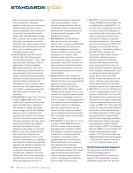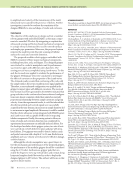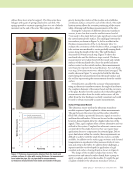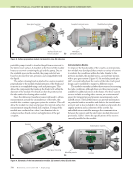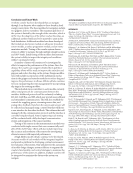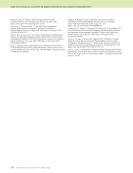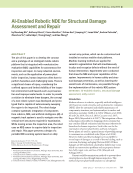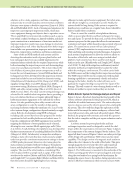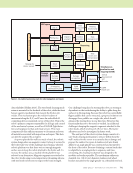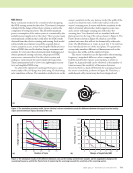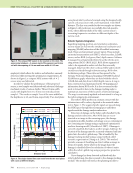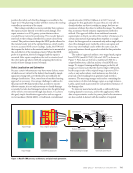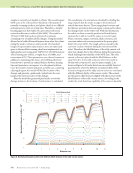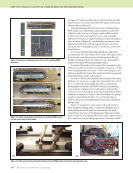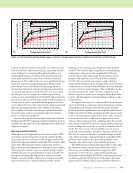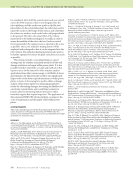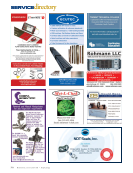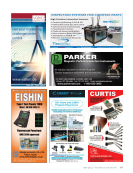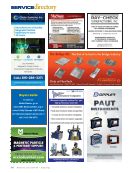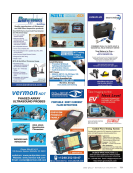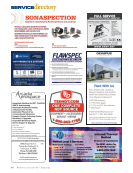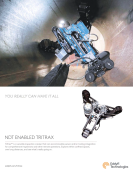682 M A T E R I A L S E V A L U A T I O N • J U L Y 2 0 2 1 arm (not shown). It too has a collision sensor between the probe and the adapter plate. As the robot picks up this NDT tool, water is supplied to the PAUT probe as well as pneumatic pressure to extend the probe to the part surface. Figure 4 shows an example of an NDT tool used to inspect composite stiffeners (Fetzer et al. 2019). In this tool, there are many ultrasonic array sensors, each having individual articulation to encompass a composite stiffener. It is an excellent example of putting complexity in the tool design to minimize complexity for the robot path plan. Orientation, articulation, and pressure of the ultra- sonic sensors relative to the surface of the stiffeners are all designed into the NDT tool itself. With a quick way to swap out NDT tools using adapter plates, the automated robotic system is not limited to PAUT and can easily change over to other inspection technolo- gies such as laser UT or IR (Tat et al. 2017). When using the NDT tools during inspection, it is very helpful to keep the robot’s TCP normal to the part surface and to hold the Z-axis rotation constant. Keeping the Z-axis rotation constant assures proper data stitching and data alignment for analysis. For some techniques (for instance, ultrasonic beam steering and eddy current phase rotation), alignment of the Z-axis rotation to the NDT data is critical to data integrity. For the PAUT data collection used herein, angular corrections for the ultrasonic tool’s X, Y, and Z axes relative to the TCP frame are zero, resulting in the identity matrix for Equations 1, 2, and 3, respectively (Craig 2004). This greatly reduces the complexity of mapping the ultrasonic data received from the PAUT instrument to the positional data derived from the robot’s TCP. It also assures that the ultrasound waves will enter the part surface at a normal angle for optimal signal integrity. (1) (2) (3) To take advantage of the reduced complexity for data mapping, a robot path plan is created to keep the TCP normal to the part surface with a fixed Z-axis rotation of zero degrees. Figure 5 illustrates keeping the TCP normal to the part surface while scanning. There is a large distance between the TCP and the part surface where the NDT tool would reside. Currently, Rx(’) = 1 0 0 0 cos(’) &sin(’) 0 sin(’) cos(’) % $ # # # " ! Rx 0) ( = I Ry(’) = cos(’) 0 sin(’) 0 1 0 &sin(’) 0 cos(’) % $ # # # " ! Ry 0) ( = I Rz(’) = cos(’) &sin(’) 0 sin(’) cos(’) 0 0 0 1 % $ # # # " ! Rz 0) ( = I ME FEATURE w automated robotic systems for aerospace ndt Figure 4. Skin panel stiffener NDT tool used to inspect composite stiffeners. It contains many PAUT sensors designed to provide 100% part coverage as the robot moves the NDT tool along the stiffener. Figure 5. Keeping the tool center point (TCP) normal to the part surface. This is useful to maintain optimum ultrasonic signal integrity.
J U L Y 2 0 2 1 • M A T E R I A L S E V A L U A T I O N 683 this distance is not represented in the 2D C-scan system output, so a translation for the Z offset is not used. PAUT Inspection Instrument Phased linear arrays are heavily used for the NDT of aerospace composite parts. Benefits include resolu- tion, sensitivity, balance along the crystal, and inspec- tion speed. When combined with the articulation and speed of a robot, the benefits of both technologies offer advantages for the inspection of curved aerospace parts such as skin panels and fuselage sections. One advantage is the reduced complexity of motion path planning in the index direction. Figure 6 illustrates a robot performing NDT of a small composite panel. There is a raster pattern on the panel indicating the robot path plan, which was generated by the simulation software. The output of the PAUT system will be a C-scan that maps ultrasonic data within a 2D display. To create the C-scan, the robot moves the linear array sensor in the scan direction while collecting ultrasonic data at a predeter- mined sampling resolution. At the end of the scan path in the raster pattern, the robot moves the array up the panel in the index direction. During the next scan pass, the robot returns in a negative scan path direction, again collecting ultrasonic data. This raster pattern is repeated for the majority of the panel. Edge scanning might be needed to fill in gaps along irregular panel edges. Local positional accuracy in the index direction of an NDT C-scan is established by the PAUT instrument and the linear array. Variables such as element pitch, element step, and array offsets are used to calculate where the ultrasonic focal points are along the index direction. For example, if the center spacing of one element to the adjacent element in the array is 2 mm pitch and the element step is two, the spacing between the ultrasonic focal points will be 2 mm × 2 or 4 mm (Tumsys et al. 2014 Olympus 2004). Ultrasonic responses from the focal points are placed in the C-scan by the PAUT instrument. This is repeated until the PAUT instrument has electronically swept through the elements used in the linear array. Since the PAUT instrument is essentially scanning through the array in the index direction, the robot needs only to provide a course index move to align the linear array for the next scan pass. This is illustrated in Figure 7, which shows an index move over a part held in a horizontal position. The index move includes a small overlap of the array to properly align the ultra- sonic focal points. Index direction Scan direction Figure 6. Illustrating the robot scan pattern using a linear array sensor. Scan and index directions are typical for the creation of an ultrasonic C-scan. Robot index move 1 Linear array Anomaly X Y Z Ultrasonic focal point resolution Part surface Linear array Linear array Robot index move 2 Figure 7. Robot index moves for a linear array sensor along a horizontal part surface.
ASNT grants non-exclusive, non-transferable license of this material to . All rights reserved. © ASNT 2025. To report unauthorized use, contact: customersupport@asnt.org



























































